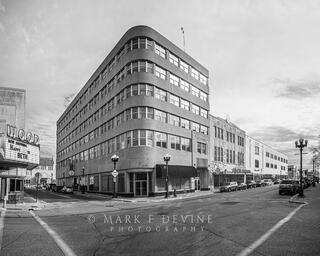2022 Retrospective: Infrared Art and Architecture #1
Pickwick Mill in Pickwick, Minnesota. January 2022
Category: Infrared Art and Architecture

This is an infrared winter view of Pickwick Mill in Pickwick, Minnesota. The structure, which sits astride Big Trout Creek, is open as a museum during the summer months.
The Subject
This local gem sits astride Big Trout Creek in Pickwick Minnesota. Completed in 1858, it started life as a sawmill, and was then converted to a flour mill. It has the distinction of being the first commercial flour mill west of the Mississippi River. Built of local limestone, its main timber framing is so precisely cut and fit that it uses no nails.
Today the mill is a historic site and museum, open in warmer months. Visitors can view antique original as well as restored equipment powered by a fully functional 20 foot overshot water wheel.
The Composition
This particular day we were simply cruising the coulees, enjoying a bright January day. As we passed over the bridge near the mill I noticed a wreath on the door. I have photographed this building before, and the bright light on the stonework along with the wreath seemed to make a nice composition. Our mini road trip was not supposed to be a photo outing, but I try to always have a camera along - just in case. I promised my best friend, travelling companion and wife (all the same person) that I would not be long.
I parked nearby, hopped out and scooted back and forth across County Road 7, capturing the mill from a number of angles. Five minutes and we were out of there, resuming our winter ride. I felt that I had something nice - but confirmation of that would have to wait until I could process the captures.

Creating the Image
I did manage a nice number of interesting captures. I combined two sets of three exposure-bracketed captures into one mini panorama. This panorama was then adjusted for perspective and I applied an initial crop. Conversion to black and white was next, then various local adjustments for noise and minor sharpening, followed by removal of power lines and final cropping. I did final cropping last, as this image has enough room to accommodate various aspect ratios.
This Pickwick Mill image has been popular with online and in-person viewers; it has been purchased in a variety of formats: greeting cards, artist studio prints and acrylic prints. You can read about the various reproduction options on my website (select Prints Available under the image above) and view a 16x24 acrylic version in person at Gallery 1802 in La Crosse, Wisconsin.
Infrared Image Capture and Processing: Capture and Image - Object to Output
I tend to call the acquisition of original files 'captures' and the final product 'images'. (Not exclusively - but quite often. :-) That terminology is something I use to convey how I view the progression from seeing a subject to capturing raw material about that subject to working on that raw material with various tools and processes to having a final image.
This kind of distinction seems to be most meaningful when I do infrared photography. When we see the object in real life, we do not see the infrared light. The camera acquires that infrared light along with other information about the object. Using tools and processes, I create a visible image that represents various attributes (forms, shades, proportions) that I want to draw out of that raw material.
Bonus Image: The First Photographic Image that I Ever Sold
I began to experiment with infrared photography in August of 2001 in Door County, Wisconsin. We were staying on one of the oldest farms in Door County. My main subjects were the structures on that farm and various local landmarks.
My camera was a 2.0 MP Olympus C-2100 UZ (ultra-zoom). No raw image capture. When I wanted to shoot in IR, I would attach an R72 filter to the front of the lens. I was using Photoshop 4.0 at that time, which seems pretty limited by today's standards, but allowed me to do some interesting things with my red-hued infrared jpg captures.
I created a poster from the resulting images and showed it to the friends who owned the farm, as well as some other friends. A couple who were decorating their home wanted to buy a set infrared images and have them professionally framed. I did not know what to say! They insisted on paying me - and that became my first-ever sale of a photographic image.
This particular image of the Cana Island Lighthouse was the favorite pick of the pack back then - and it remains my favorite of the grouping to this day.

Cana Island Lighthouse in Door County Wisconsin




